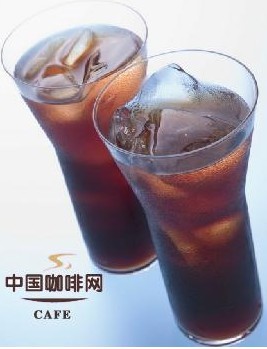The content of caffeine in drinks should be limited to 2%.

At the end of the 19th century, coffee sales in the United States increased greatly. John Pemberton, a pharmacist in Atlanta, Georgia, has made an innovation. He used coffee as a basic ingredient to make a cold drink that relieves fatigue, creating a competitor to coffee, Coca-Cola, which contains caffeine and is made from syrup extracted from two Latin American plants. Pemberton made the Coca-Cola recipe out of a three-legged brass can in his backyard. The name comes from Pemberton's accountant Frank Robinson,Robinson, who loves calligraphy. He wrote "Coca Cola" in a special way, like a flowing letter, and later became a world-famous trademark. The soft drink was first sold at the Jacob drugstore in Atlanta on May 8, 1886. He sells about 9 tins a day, selling $50 in the first year, less than his $70 investment. Coca-Cola's first-year sales were not as profitable as they are now. Later, other smart Americans invented hamburgers instead of steaks and replaced natural fruit juices with all kinds of soft drinks. 、
Before 1903, the soft drink was sold on the market as a tonic with ingredients including cocaine and caffeine-rich Coke tree nut extract. Later, FDA banned the sale of drinks containing cocaine and limited the amount of caffeine in drinks to 2 per cent. Nowadays, this synthetic carbonated drink, which can relieve fatigue, is very popular. The basic ingredients in its regular formula include sugar and caffeine, while Diet Coke's formula does not contain sugar. Large bottles of 600 to 2-liter drinks contain 120-400 milligrams of caffeine, the equivalent of 1-3 cups of coffee. At present, this synthetic caffeinated carbonated drink is popular with children, teenagers and adults around the world. Although there are no reports of harm to health, the man-made foods and drinks seem to have something to do with obesity, a major problem for young Americans. Recent data have shown that caffeine intake from carbonated drinks may be associated with high blood pressure, benzene poisoning and cancer in young people. By the late 1890s, Coca-Cola became one of the most popular carbonated drinks in the United States, and Coca-Cola's sales increased 40-fold between 1890 and 1900. Attractive advertising is one of the important factors for its success. After a hundred years of operation, it has been sold all over the United States and Canada. In the early 20th century, the company began to sell syrup to independent bottling companies to authorize it to sell drinks. Today, the huge American soft drink industry operates on this principle. Although Pemberton's original idea was to invent a health drink, a drink that nourishes the body and brain, it was an idea and did not conduct medical trials.
Important Notice :
前街咖啡 FrontStreet Coffee has moved to new addredd:
FrontStreet Coffee Address: 315,Donghua East Road,GuangZhou
Tel:020 38364473
- Prev

It is healthy to drink coffee in moderation during the day.
Studies in England and Denmark have found that people who drink alcohol have a high incidence of coronary heart disease, but surprisingly, people who do not drink at all have a higher incidence of coronary heart disease. It is worth noting that Europeans usually drink wine and water with meals, while Americans often drink milk, iced tea, soft drinks or coffee. Drinking red wine in moderation can prevent heart disease and some tumor diseases.
- Next

The name Papa Palheta gets from drinking coffee is not just about drinking coffee.
It sounds a little mysterious. But go to Papa Palheta in Wuji Zhi Road, a bit remote, not easy to find baking place and guest experience, you can understand what he means. Drinking coffee is not just about drinking coffee. There is no charge for coffee. Just tip the chef at 3: 00 p. M. on a Tuesday. The small reception room is full. In the open courtyard, sitting in one corner
Related
- Beginners will see the "Coffee pull flower" guide!
- What is the difference between ice blog purified milk and ordinary milk coffee?
- Why is the Philippines the largest producer of crops in Liberia?
- For coffee extraction, should the fine powder be retained?
- How does extracted espresso fill pressed powder? How much strength does it take to press the powder?
- How to make jasmine cold extract coffee? Is the jasmine + latte good?
- Will this little toy really make the coffee taste better? How does Lily Drip affect coffee extraction?
- Will the action of slapping the filter cup also affect coffee extraction?
- What's the difference between powder-to-water ratio and powder-to-liquid ratio?
- What is the Ethiopian local species? What does it have to do with Heirloom native species?

